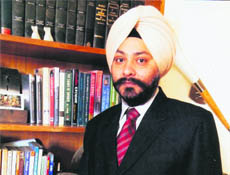|
Punjabi Antenna
Extensive poll coverage
Randeep Wadehra

SP Singh comes across as a sharp, witty and
well-informed anchor |
IS
the general election, 2009, going to be a watershed event in the
brief history of Indian democracy? Have politicians been
deliberately ignoring substantive issues and indulging in
frivolous backchat (Amarinder v/s Badals, Manmohan Singh v/s
Advani)? If so, what could the purpose be? More importantly,
what does the increasing Naxalite violence indicate vis-`E0-vis
the future of democracy in India?
These were some
of the issues that the panelists on Zee Punjabi’s talk show, Khabarsar
— Prof Manjit Singh, senior journalist Gobind Thukral and
trade union leader Chandershekhar — discussed
threadbare. They pointed out how the focus on mainly urban
middle-class issues, along with the vote-bank politics that
marginalises the rural poor and the urban underdog, is causing
resentment among the deprived masses. The Leftist discourse has
been dominating the last few episodes of the show.
Whether it was
the edition related to Punjab’s developmental issues or young
politicians’ lack of ideals and vision, Leftist intellectuals
were prominent panelists. One may not agree with their ideology
but Leftists remain major legitimate repositories of idealism.
Khabarsar’s
moderator, SP Singh, is a seasoned, grassroots-to-treetops
journalist. A product of ‘Ludhiana’s Punjabi medium schools,
sitting in classrooms on mats, cross-legged,’ he has worked on
the national as well as foreign desks with the Press Trust of
India. As a guest of the European Commission in 1996, he had
toured various European countries with special interest in the
EU’s formation.
He has also
been a fellow of the IIAS, Shimla, "working on the
socio-cultural layers of the civilian discourse between conflict
societies like India and Pakistan". He has been covering
Punjab politics quite extensively. In the various episodes of Khabarsar,
SP Singh comes through as a sharp, witty and well-informed
anchor.
However, it
would enhance the viewing experience if he eschews the
propensity to cut off panelists in mid-sentences.
Coming back to
the coverage of elections, Zee Khabran has been carrying
extensive reports on individual candidates — their declared
assets, past performances and current promises. On the other
hand, PTC News has come up with quite a number of
election-related programs. In its Faisla, 2009,`A0a
special segment in the PTC news bulletins, it provides daily
updates, several times a day. Poll Hour, an hour-long
programme telecast Mondays to Saturdays, discusses latest
poll-related developments.
The show has
three segments — Chon Sargarmiyan, Campaign Trail and
Halkeyan Di Choun Gatha. Chon Sargarmiya highlights
daily special updates on Punjab elections, which is followed by Campaign
Trail, following a contestant as he/she campaigns
through the day. It also focuses on the problems faced by their
respective constituencies and the steps they plan to undertake
to resolve them. The last segment, Halkeyan Di Choun Gatha,
profiles various locales in Punjab.
Another show, Chon
Mudde, discusses issues that are of national importance with
a potential to impact the region — the nuclear deal,
agriculture-related problems like loan waiver, maximum support
price & food security, and also internal security &
terrorism, as well as recession. Of course, Masle remains
the most thought-provoking talk-show with adequate gravitas.
Zee Punjabi telecast Taliban
da Jazia on April 24. The medieval age has apparently
arrived in our neighborhood where non-Muslims have to pay the
extortionist tax Jazia (a tax that the Mughal emperor,
Akbar, had reputedly condemned) to the Taliban in Pakistan’s
Swat valley and elsewhere. According to the TV report, recently
Sikhs had to pay Rs 2 crore as Jazia. Many Hindu and Sikh
families, who have fled to Amritsar to protect their life and
honour, were interviewed by the channel. Is the region in for
another humanitarian crisis like the one that had engulfed the
country during the Bangladesh liberation war?

|